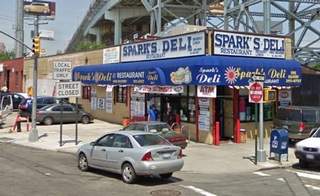People like to eat. People like to eat out. People are interested in how their favorite eateries stack up against others.
.jpg) It’s a standard story that is being repeated in countries across North America: what restaurants in a region get lousy (and occasionally disgusting) inspections, and what is the best way to make those results available to the public?
It’s a standard story that is being repeated in countries across North America: what restaurants in a region get lousy (and occasionally disgusting) inspections, and what is the best way to make those results available to the public?
The Ottawa Citizen chipped in with a three-part series that wraps up Monday and found 44 per cent of area restaurants and take-out places were cited for a failure to comply with health regulations in the past year.
Since April, Ottawa has made its food inspections available online through a searchable database called EatSafe. Users can type in the name or location of the restaurant to see inspection results (ottawa.ca/eatsafe).
Mike Ziola, president of the Ontario Restaurant Hotel and Motel Association ‘s Ottawa chapter said Ottawa doesn’t need the colour-coded food safety system used in Toronto, where restaurants are required to post a green, yellow or red warning sign based on their most recent inspection, stating,
“Essentially, a yellow is a red. I don’t know why they even have a yellow.”
Oh. Oh. I do. When Toronto introduced it’s system the restaurant association made the same argument and the city hired me to write a report for the pending court case – which never went to court. Yes, a yellow is like a red, but it allows the restaurant to stay open. And no one wants a yellow, so the percentage of greens has increased dramatically.
Same thing in New York. The Times quotes Geoff Kravitz, a spokesman for the Staten Island Chamber of Commerce, as telling the first public hearing Friday considering the city’s proposal to rate restaurant cleanliness with posted letter grades, as saying,
.jpg) “Letter grades are nothing more than a scarlet letter that will keep people from eating out.”
“Letter grades are nothing more than a scarlet letter that will keep people from eating out.”
Any evidence to support that opinion? Have letter grades in Los Angeles kept people from eating out?
The New York State Restaurant Association maintains that letter ratings would encourage bribery and corruption – since the highly public placards would dramatically raise cleanliness ratings’ significance to restaurateurs.
Always a risk, but the best restaurants will embrace the disclosure system and promote their excellent results.
The Times story notes that in Los Angeles, the letter system has been in effect for more than a decade. According to a 2007 study by the county’s health department, 91 percent of the populace likes the letter-grading plan. But one speaker, Robin Werteheimer, said that restaurateurs in New York “are not Los Angeles,” adding that “most of their buildings are not 200 years old, and most of them are not next to empty lots with hundreds of rats. It would be nice if the city would clean up those lots.”
Cleveland has new on-line access to restaurant inspection reports, but some are already demanding information on the door.
The New Brunswick Health Department makes all restaurant inspection report cards available to the public on the provincial government website. They can be found at www.gnb.ca under Food Premises Inspection Results.
The province started posting inspection reports on its website in 2007, mainly as a way for restaurant customers to keep an eye on food service establishments.
In Wisconsin, Nancy Eggleston, Wood County environmental health and communicable disease supervisor, said the state will begin the switch from paper to paperless forms of restaurant inspection records, and counties will have the option of placing the inspections on a Web site to make them easily available to the public.
And that’s just one weekend worth of stories. People like this stuff. No politician wants to say, “you, citizen, can’t have this information.” The challenge is to provide the disclosure results in a fair and meaningful manner.
 Crain’s New York Business (photo from Crain’s) reports the agency is holding a press conference Wednesday morning at Spark’s Deli on 2831 Borden Ave., where health commissioner Dr. Thomas Farley will laud the small business’s accomplishment.
Crain’s New York Business (photo from Crain’s) reports the agency is holding a press conference Wednesday morning at Spark’s Deli on 2831 Borden Ave., where health commissioner Dr. Thomas Farley will laud the small business’s accomplishment.
 Breast milk is for babies, not food porn.
Breast milk is for babies, not food porn..png) Officials estimate that about 6,000 of the city’s 24,000 eateries had enough violation points in June to have earned the lowest mark on a three-letter rating scale devised by the city.
Officials estimate that about 6,000 of the city’s 24,000 eateries had enough violation points in June to have earned the lowest mark on a three-letter rating scale devised by the city..jpeg) Samples are taken monthly by the State
Samples are taken monthly by the State.png) system, and the arguments haven’t changed: people want the information, good restaurants promote their good food safety scores, and the various lobbies think the system is silly.
system, and the arguments haven’t changed: people want the information, good restaurants promote their good food safety scores, and the various lobbies think the system is silly..jpg) Marc Murphy, chef and owner of Landmarc Restaurant in TriBeCa, said that average diners “will see a C grade and no one will come in — they might as well close shop. Everyone in our business is not against health inspections, but we don’t want bad letter grades from trivial infractions.”
Marc Murphy, chef and owner of Landmarc Restaurant in TriBeCa, said that average diners “will see a C grade and no one will come in — they might as well close shop. Everyone in our business is not against health inspections, but we don’t want bad letter grades from trivial infractions.” say they all got sick afterward.
say they all got sick afterward..jpg) favors the idea. In a recent survey by my company, 83 percent of respondents said that they would like to have grades posted. …
favors the idea. In a recent survey by my company, 83 percent of respondents said that they would like to have grades posted. ….jpg) Robert Bookman, legislative counsel for the New York City chapters of the New York State Restaurant Association — the operators’ trade group — told
Robert Bookman, legislative counsel for the New York City chapters of the New York State Restaurant Association — the operators’ trade group — told .png) test results on the website — to help enhance trust with the buying public. And the best restaurants will proudly proclaim their A.
test results on the website — to help enhance trust with the buying public. And the best restaurants will proudly proclaim their A. Foodborne or not, it’s not cool to barf on other people. Even celebrities.
Foodborne or not, it’s not cool to barf on other people. Even celebrities. .jpg) It’s a standard story that is being repeated in countries across North America: what restaurants in a region get lousy (and occasionally disgusting) inspections, and what is the best way to make those results available to the public?
It’s a standard story that is being repeated in countries across North America: what restaurants in a region get lousy (and occasionally disgusting) inspections, and what is the best way to make those results available to the public? .jpg) “Letter grades are nothing more than a scarlet letter that will keep people from eating out.”
“Letter grades are nothing more than a scarlet letter that will keep people from eating out.”